Chinese gods and goddesses
In this section we list all the key figures in Chinese myth, folklore and history. First we describe the eight immortal gods of folklore followed by an A-Z guide to assorted gods, goddesses and heroes.
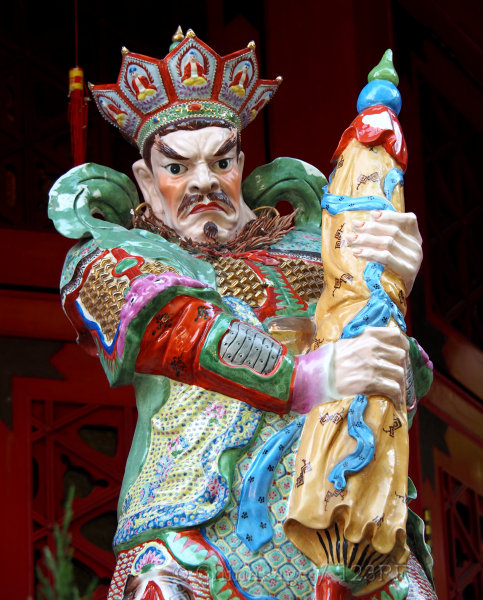
A knowledge of the Chinese traditional gods and goddesses (deities) is particularly useful when visiting ancient temples or reading ancient texts. Many of the traditional gods started off as mere mortals and some went on to have a particular festival dedicated to them. These deities are often seen as sculptures in temples but they may also appear in other forms of decorations, some have a symbolic meaning, for more on these see our extensive symbolism section.
People familiar with the Egyptian, Greek or Roman pantheon of gods will be disappointed when considering the Chinese deities. There is no consistent framework or hierarchy, it is more of an assorted collection, suggesting the stories come from different places at different times. The ‘Supreme’ deity Shangdi 上帝 does not feature in many tales and does not interact with other gods, and so can not be compared to Zeus or Jupiter. The chief reason for this is that Confucianism has generally been the dominant philosophy, and that is firmly rooted in rationality and the here and now. So the mythological figures were not considered suitable subjects for scholars, it was mainly the illiterate who kept the stories alive by oral tradition. Perhaps as many are half are based on historical figures who became ‘gods’ to honor their deeds and virtues. History has a long tradition for accuracy in China; the impartial recording of facts is at odds with creative imaginings. However the ancient deities of folk religions have always been cherished by the people so they can get together and enjoy festivals in their honor. Up until recently, large cities like Beijing would have had a commemorative festival every day of the year at one of the thousands of temples dedicated to one of these many different deities.
Ba xian 八仙 (Eight Immortals)
The Eight Immortals feature in a famous legend in China. The character 仙 for immortal is made up from the character for man and mountain evoking the age old link of mountains as the haunt of deities. They are frequently depicted on vases, embroidery, porcelain and items of folk-art. Mostly they are associated with a magical voyage across the seas to the Isles of the Blessed. Each used their own magical power to stay afloat. They then fought and defeated the Dragon King and embarked on a series of adventures together. The eight immortals comprise historical figures from various ages and represent different facets of human existence - everyone has one with whom they feel some affinity. Each is depicted holding some kind of object and these in isolation can symbolize the immortal. There are eight similar Buddhist Immortals that can also be distinguished by the objects they hold.
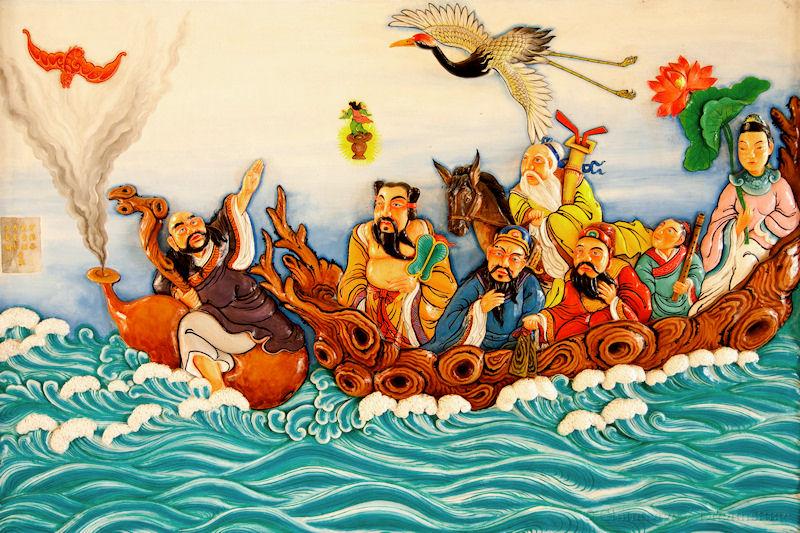
Li Tie Guai 李铁拐
Lǐ tiě guǎi (or Li T'ieh-kuai WG) is a person skilled in medicine, he is portrayed with a gourd full of potions often with a bat. He is also known as Kong Mu and Li Ningyang. The story is that a disciple was instructed to wait and then burn his body after a week while he went off on a voyage as a spirit. Returning to find his body had been destroyed a day too early he was forced to inhabit the body of a beggar who had just died. The beggar had a paralyzed leg and so Li was given an iron stick for support. His eyes did not fit the beggar's head properly and give the impression of Hollow Eyes (hence the name 空目 Kōng mù). He is often represented standing on a crab or accompanied by a deer. Symbol: bottle gourd.
Zhongli Quan 钟离权
Zhōng lí quán was an army marshal who on retirement took to a hermit's life in the Yangjiao mountains, Hunan. The Five Heroes taught him about immortality and how to turn copper into silver. He then produced silver which he gave to the poor. One day a wall of his house collapsed revealing a jade box containing the secrets of immortality. After a while he mastered the spells and was whisked off by a celestial crane to the land of the immortals. His magical fan has the power to bring the dead back to life. He is also known as Han Zhongli 汉钟离. He is depicted as a fat man with a bare belly carrying a feather fan and/or a peach of immortality. Symbol: fan.
Lan Caihe 蓝采和
Lán cǎi hé is portrayed as a woman or a hermaphrodite wearing a blue gown. As a mortal she lived as Yang Su of the Tang dynasty. She is depicted playing a flute or cymbals. She traveled the empire singing with one shoe off and one shoe on. Her breath was of shining mist. One day she was found drunk in Anhui and disappeared into a cloud leaving her shoe, dress, belt and castanets behind. She laments the short and fleeting life of mortals. Symbol: flower basket.
Zhang Guo Lao 张果老
Depicted as an old man, Zhāng guǒ lǎo lived as a hermit of the Tang dynasty in Shanxi. He was then invited to attend Tang Emperor Taizong but refused. Later on he accepted a request from Empress Wu Zetian but he died on reaching the capital. He was immediately reborn in the Hengzhou mountains. He rode a white mule that could cover a thousand li in a day. The mule or donkey could be folded up as if it was made of paper and conveniently stored away. He performed magical tricks for the Tang Emperor Xuanzong. He carries a bamboo tube drum with two rods to beat it; he is often shown seated on a mule with may be peaches or phoenix feathers. Symbol: bamboo tube drum.
He Xiangu 何仙姑
Depicted as holding a magic lotus flower (which opens the heart) and playing the sheng, Hé xiān gū (or Hé Qióng) lived in the reign of Empress Wu Zetian. Once she was threatened by a demon and rescued by Lu Dongbin. She moved to the Mother of Pearl Mountains and was shown how to achieve immortality by taking a magic potion. She then flew among the mountains picking fruit for her mother. She represents purity and self sacrifice. Symbol: lotus or peach.
Lü Dongbin 吕洞宾
In 755 Lǚ dòng bīn was born in Shanxi into a family of officials. He went off to Lushan mountain, Jiangxi and met a fire dragon who gave him a sword with the power of invisibility. At Chang'an he met Han Zhongli who taught him magical powers and immortality. He proved his skills by performing ten arduous tasks. For four hundred years he traveled the country killing dragons and preventing catastrophes. A tale relates that when visiting a wine bar instead of paying cash he painted two beautiful cranes on the wall, many came to see the realistic painting and the bar prospered, but as soon as Lu's debt was paid by the increased trade the cranes detached themselves from the wall and flew off. He was also known for his scholarship. He is depicted with a devil-killing sword and a fly-whisk ➚ (云展 yún zhǎn) that enabled him to walk on clouds. Symbol: sword of fly-whisk.
Han Xiangzi 韩湘子
He was probably the great nephew of the famous Tang statesman Han Yu (c. 820CE). He soon excelled in horticulture. He could grow plants in a small handful of earth and became a pupil of Lü Dongbin. He then became immortal by climbing into the peach trees of Immortality and falling to the ground. His melodious playing of the flute attracted the birds and animals and he is the patron of musicians. He saw no value in money and gave away any he was given. Symbol: flute.
Cao Guojiu 曹国舅
Cáo guó jiù (930-999CE) was elected by the immortals to make up the set of lucky eight. He met Han Zhongli and Lu Dongbin who asked him what he was doing, when Cao Guojiu replied he was ‘Looking for the Way’ and then asked ‘Which way and where?’ Cao Guojiu responded by pointing to his heart. The immortals were impressed by this, as ‘The heart is heaven and heaven is the Way’ and he was soon given immortality. He is usually shown holding a scepter and castanets. He is the patron of actors. Symbol: castanets or ruyi.

Deities A-Z
The remaining deities are listed in alphabetical order.
Avalokiteshvara
The Avalokiteshvara is a ‘future Buddha’ entering enlightenment who has chosen to stay in this world to help mankind. In China this deity has merged with the deity Guanyin. Many depictions are found in Buddhist temples, the original form when it come from India is distinctly male while in later centuries in China the form became female.
Bao Zheng 包拯
Bao is a historical figure who lived 999-1062CE in the Song dynasty . He was a revered figure with temples dedicated to his honor at Kaifeng, Henan and elsewhere. He passed the Imperial Examinations but instead of taking up a lucrative post at court went home to look after his parents (another example of filial piety). He eventually took up posts as a magistrate, governor and emissary. His claim to fame was his incorruptibility as he was an honest and upright judge. He is also known as 包青天 Bāo Qīng tiān. He offered access to justice to all and stamped out corrupt practices, even in his own family. He lived modestly and he is held up as the model for all officials to try to follow. He is a common figure in operas and popular TV series have been made about him.
Bixia Yuanhun 碧霞元君
The first Princess of the Purple and Blue Clouds is associated with childbirth. One deity of this name came from Fuzhou, Fujian and was the daughter of a great magician. Bì xiá yuán jūn moved to a palace on the seas. The other deity of this name is the daughter of the God of Taishan mountain, Shandong. The legend talks of Jiang Taigong who ruled so well and so virtuously that no storms came. As the princess needed storms in order to travel through the kingdom he had to move out of his kingdom so that the princess could pass. She is easy to confuse with the Queen Mother of the West but can be distinguished by having three phoenixes in her headdress.
Cai shen 财神
The ‘God of Riches and Prosperity’ is an important and highly regarded deity. There are at least three candidates for the title. One of them 赵公明 Zhào Gōng míng lived for a while as a hermit on Emei mountain at the time of the fall of the Shang dynasty. He rode a black tiger and had magic pearls that would explode as grenades. Jiang Ziya defeated him by making an effigy of Zhao and shooting it with arrows. Zhao fell dead but the Jade Emperor took pity and made him the god of wealth. Sometimes the god of riches is represented by a pair of figures, one of them is the ‘god of war’ Guandi or the ‘heavenly twins’ He-he. Some think the different incarnations represent different departments of the heavenly Treasury. Many Chinese homes will have a statue or two of him - he is shown with a gold ingot and a scepter or ruyi. The 15th day of the 3rd lunar month is his festival date but he also honored on the fifth day of the New Year. He is the closest to Santa Claus in the pantheon of Chinese deities.
Cao Guojiu 曹国舅
One of the Eight Immortals - See above.
Chang'e 嫦娥
The Goddess of the Moon Chang’e (or Chang Er) stole the potion of immortality from her husband the Archer God Hou Yi and fled to the Moon. There she is kept company by the Jade Rabbit. Her husband then visited and built a palace for her there, they now meet at full moon each month. Another legend says she changed into a tortoise that can be seen as the markings on the moon's surface. The Mid-Autumn Moon Festival celebrates Chang’e and her story. [For information about China’s voyages of exploration to the moon read here; the lunar modules have been named Chang’e in deference to the goddess.]
Chen Sheng 陈胜
A leader, who with Wu Chang led a rebellion against the Qin dynasty to set up the Chu kingdom before the Han dynasty was founded. He is often seen in effigy as a door guardian (with Wu Chang) of Daoist temples.
Cheng Huang 城隍神 or City God
This deity defends cities and so is master of moats and ramparts. He is also regarded as the supreme minister of justice. Each town or city had their own version of Cheng Huang ➚ as their own local 'god'. To many, this was one of the most important deity of all as the god controlled local issues and was called upon to help on day-to-day matters: sickness, poverty and family strife. He would be called upon to save the whole community from calamities such as famine, disease and flooding.
Da Fan Tian Wang 大梵天王
The Chinese name for Buddhist Brahma ➚, the ‘Father of all Living Things’. He is also considered the Soul of the Universe who hatched the Cosmic Egg.
Er Lang 二郎
This deity is best known for its appearance in the book Journey to the West where he was considered the nephew of the Jade Emperor. He may be based on the historical figure Li Erlang 李二郎 who was a son of Li Bing the water engineer in the Warring States period who developed irrigation in Sichuan.
Feng Bo 风伯
The Duke of the Winds is depicted as an old man with a large sack, a white beard, yellow coat and red and white cap. Winds issues forth from his mouth.
Fo Tuo 佛陀 or Da Fo 大佛
Fo Tuo is the Chinese name for the Buddha. The full name Amitābha in Sanskrit is transliterated as 阿弥陀佛 Āmítuófó.
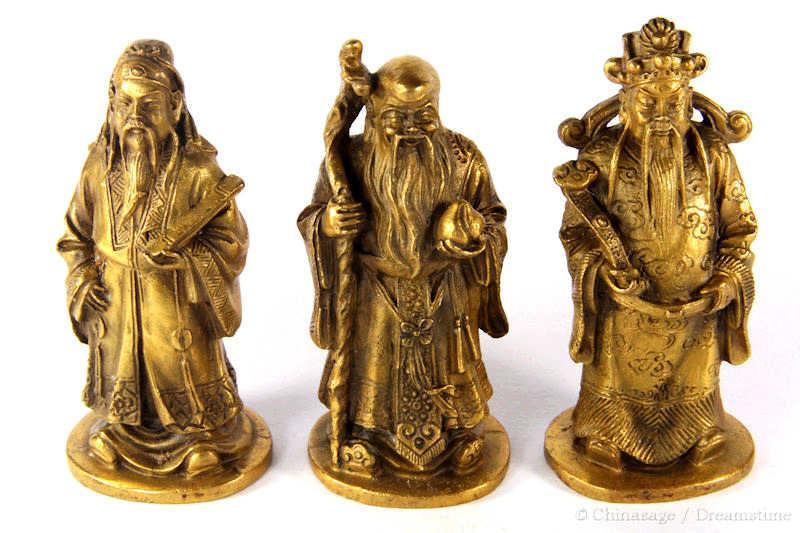
Fu, Lou and Shou
Fu Shen; Lou (or Lu) and Shou 福禄寿 Fú Lù Shòu form a trinity of deities bringing good luck, respectively: Happiness; Prosperity and Longevity. They are often portrayed together in statues; ornaments and paintings. Collectively they are also known as the Three Star Gods as they are each associated with a star. They are associated particularly with Feng shui and Daoism. Fú shén 福神 (Happiness) is usually depicted with a scroll, and sometimes with children. The good luck character Fu 福 is a representation of him as the ‘God of Happiness’. Historically he was a judge in Hunan who rebuked the Liang dynasty Emperor Wudi for his predilection for making dwarfs work as jesters and slaves at court. In gratitude people began to worship his as God of Happiness, he is often shown wearing lucky red colored clothes. His 'star' is the planet Jupiter. 禄 Lù or Lou (Prosperity) wears a Mandarin's outfit. Lu is particularly associated with luck in passing examinations which were the traditional passport to prosperity as a government official. Sometimes he is mounted on or stands beside a stag and may be Chinese 'medicinal' mushrooms 灵芝 líng zhī (associated with immortality) carpet the ground. 寿 Shòu (Longevity) holds a walking stick and has a large bald forehead and often carries a peach of immortality. He may be accompanied by the long-lived bird the crane. His star is the mythical star at the South pole.
Fuxi
The first of the Three Sovereigns, considered the creator of China, he is described in the Legendary Era section.
Guan Yu 关羽 or Guan Di
The ‘God of Righteous Action’ comes by several names including 关公 Guān gōng 'Lord Guan'; Wu di and Guan Di. Guan Yu was a war hero of the Three Kingdoms period and appears in the famous novel 'The Romance of the Three Kingdoms'. He swore loyalty to Zhuang Fei and Liu Bei. He was captured and executed by Sun Quan. The Ming Emperor Shenzong elevated him to the status of a Daoist god. He is one of the most widely represented Chinese deities. Although termed a ‘god of war’ he is really about strategy, dignity and loyalty rather than aggression and violence - so ‘God of Righteous Action’ is a better description. The Qing Emperors took steps to lionize Guanyu and raise his stature. As well as the patron of all soldiers he was noted for his scholarship and is venerated for his knowledge of diplomacy and acquisition of riches. He is often portrayed in opera as a general on horseback with a red face and green robe. His birthday is celebrated on the thirteenth day of the fifth month.
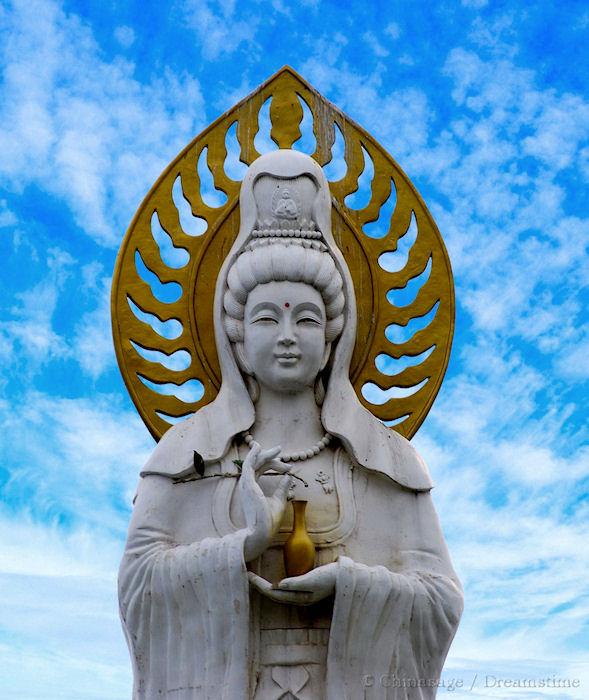
Guanyin 观音
The Buddhist Goddess of Mercy ➚ listens to any who will seek her help. She steers the boat carrying souls to paradise. According to legend Guanyin was the third daughter of Miao Zhuangwang. She soon decided she wanted to become a Buddhist nun. Her father continued to maltreat her and tried to break her will; when at last he lost patience, he commanded that she should be killed with a sword, but the sword broke into many pieces. Not giving up, he had her suffocated but she was rescued and re-incarnated on Putuo Island off Zhejiang. She then used a part of her own arm to heal her sick abusive father who recovered and then, suitably chastised, erected a statue in her honor. She is the protector of children and is often shown surrounded by them. She is the goddess who protected the travelers in the famous tale ‘The Journey to the West’. The statue has many (sometimes a thousand) eyes and arms apparently because the order describing the desired form was misheard. She is often portrayed sitting on a lotus and accompanied by a boy with a bottle and a girl with a willow twig. Her birthday is celebrated each year on the 19th day of the 2nd lunar month.
In some ways she is similar to the Blessed Virgin Mary ➚ in Christian theology - she is compassionate and pure. The origin is probably from the youthful Avalokiteśvara Bodhisattva of Indian Buddhism, the Dalai Lama is considered a reincarnation of Avalokiteśvara- the original god became a goddess in the Chinese tradition.
Han Xiangzi 韩湘子
One of the Eight Immortals - See above.
He-he Heavenly twins 和合二仙
The Heavenly twins are shown as two boys carrying a box and a lotus which symbolizes a wish for peace: hé 和 (box) and harmony 荷 hé (lotus). One may also be holding a bowl over which fly five bats for good luck; it represents a wish for family peace and harmony. They may be based on the story of Shi de 拾得 the eccentric friend of the legendary poet Han Shan 寒山.

Heng and Ha 哼哈二将
Generals Heng and Ha are frequently depicted as statues guarding Buddhist temples. The legend is that they lived at the time of the foundation of the Zhou dynasty and were given magical powers by Duè Zhenrèn who lived in the Kunlun mountains. General Heng could emit deadly rays from his nose. General Ha had been given the power to exhale a lethal gas. The two generals fought each other valiantly and they were rewarded for their prowess by being canonized by Jiang Ziya.
He Xiangu 何仙姑
One of the Eight Immortals - See above.
Hou Yi 后羿
The Divine Archer is associated with the sun and is the husband of Chang'e of the moon. His skill was discovered by Emperor Yao in 2436BCE when he claimed that he could hit a tree on a distant hill. Not only did he accomplish this but he rode the air to retrieve the arrow. Houyi ➚ (also known as Shenyi) was also skilled in carpentry, and built a palace for Chang'e on the Moon and one for himself on the Sun. Some legends say that rather like Zhinu and Nuiling, he can only visit Chang'e at the Mid-autumn moon festival. He is said to have shot and killed nine of the ten sun ravens that threatened to burn up the Earth.
Huang Di 黄帝
The Yellow Emperor - see section on Legendary Emperors.
Jade Emperor (Yudi)
See entry for Yudi.
Ji Gong 济公
The popular figure Ji Gong was a very clever Buddhist monk who took delight in wrong-footing the corrupt and helping the poor. He was a maverick, choosing to eat meat in defiance of normal Buddhist practice. He is often shown as somewhat intoxicated with wine, holding a fan or leaning against a tree. The real life figure lived during the Southern Song dynasty but after his death he was imbued with magical powers. He was popularized by a TV series ➚ in 1988.
Jiang Ziya
A historical figure from the founding of the Zhou dynasty. Later books made him a legendary demon-slayer. See section on the Zhou dynasty.
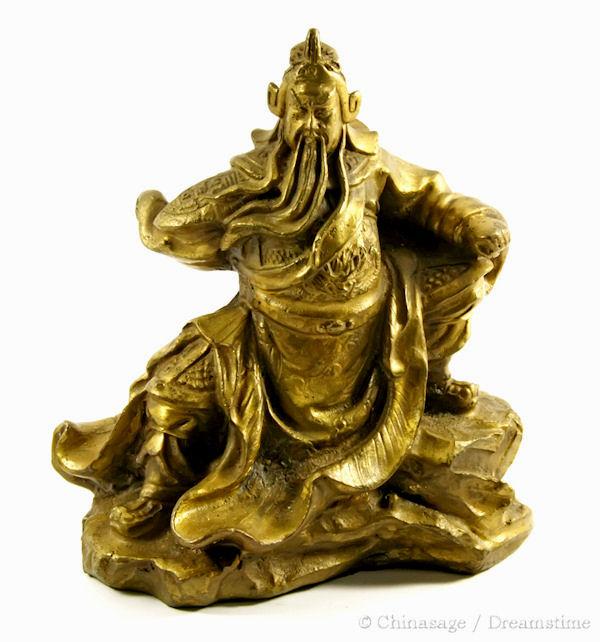
Kongfuzi 孔夫子 Kǒng fū zǐ or Confucius
The founder of the Confucian religion/philosophy - See Confucius.
Kuixing 奎星 kuí xīng
The god of literature is associated with a star in Ursa Major (the Big Dipper). There are other historical figures who are sometimes called Kuixing for example Zhong Kui and Wen Chang - it is all a bit confusing. He is portrayed with an ugly face - large eyes and a square chin often in a pose based on the configuration of the pointer stars in the Big Dipper (as they point to the North pole star). His ill looks resulted in the Emperor refusing to give him his just reward for passing the examinations, in response he threw himself in a river in despair. As god of the examinations his figure is a popular gift for aspiring students.
Lan Caihe 蓝采和
One of the Eight Immortals - See above.
Laozi 老子 Lǎo zǐ or Lao tzu
The founder of the Daoist (Taoist) religion - See Daoism.
Lei Gong 雷公
The Duke of Thunder Lei Gong, is depicted as a hideous looking black demon with bat's wings; a monkey's face and an eagle's beak. In one hand he holds a steel chisel while in the other a hammer with which he beats numerous drums.
Lei Zhenzi 雷祖
Lei Zhenzi is separate from Lei Gong but is also associated with thunder. He has three eyes, an extra one in his forehead from which a ray of light emerges. He rides a black unicorn which covers huge distances in no time. The associated rain makes him a popular god for farmers, grain merchants and inn keepers.
Liang Shanbo 梁山伯 and Zhu Yingtai 祝英台
This couple figures in one of the most famous romances in Chinese tradition and are often termed the ‘Butterfly Lovers’ or the ‘Chinese Romeo and Juliet’. Zhu Yingtai is said to have gone way to study in the house of Liang Shanbo disguised as a boy. On parting Zhu promised the hand of 'his' friend to Liáng Shānbó in marriage. When Liang completed his studies and passed the exams he went to find Zhu but in the meantime her father had forced her to be engaged to be married to another man. Liang pined away in grief and died. Some time later, on Zhu's wedding day, her carriage stopped during a great storm and she noticed the grave of Liang. In distress the ground opened up and the two were united in death, the story ends with a pair of strange butterflies emerged from his tomb. The famous violin concerto ‘The Butterfly Lovers ➚’ commemorates the story.
Li Tie Guai 李铁拐
One of the Eight Immortals - See above.
Liu Hai 劉海
Liu Haior Liu Haichan is another Daoist god of wealth often depicted with a string of coins and accompanied with a three legged toad. Various tales are told about him. The magical toad was said to be able to transport him anywhere he wished. He may have been an official during the Jin dynasty and actually an alchemist called Liu Xuanying. China has some large toad statues that are associated with wealth and many people offer him coins for good luck.
Long Wang 龙王
The Dragon King is the chief of all the dragons and controls all the waters: sea; rivers; lakes and streams. He was subdued by the combined talents of the Eight Immortals.
Lu Ban 鲁班
The God of Carpenters and Craftsmen is based on the tale of a man who lived in the Shandong province in the Spring and Autumn Period. He was given the ability to rise in the air unsupported and ride the clouds. An alternative story is that he lived in Gansu and built a kite that could lift him from the ground.
Lü Dongbin 吕洞宾
One of the Eight Immortals - See above.
Luo Han 罗汉
A Luo han or (阿罗汉 ā luó hàn) is the Chinese name for an arhat ➚, a Buddhist who has achieved enlightenment (nirvana) and is freed from all earthly cravings and so leaves the cycle of rebirths. An Arhat works for personal enlightenment compared to a Pu Sa (Bodhisattva) who works for the general good of all. There are considered to be 18 identified Luohans each with their own object or attendant by with they can be identified in pictures and figurines.
Ma Gu 麻姑
Magu or Lady Ma is an auspicious Daoist deity often shown with a bamboo staff and a boy carrying a peach of immortality or a basket of herbs. Often she is accompanied with a deer and the Queen Mother of the West. She is regarding as having lived in the Han dynasty and many temples, caves and mountains are named after her. She is most associated with having long fingernails, indeed legend has it that the Emperor wished Magu would scratch an irritating itch he had with her nails, he was punished by being whipped by a demon. A back-scratcher is often named after her to immortalize this event.
Mazu 妈祖
The Daoist goddess Mā zǔ is of importance along the coastline of Southern China as she is associated with the sea and there she is considered the Queen of Heaven. Many temples have been built so fishermen and seafarers can seek Mazu’s help in procuring good weather and a safe voyage. She is said to have 千哩眼 qiān lǐ yǎn ‘eyes that see a thousand miles’ and 顺风耳 shùn fēng ěr ‘ears for favorable winds’. She is honored on the 23rd day of the third lunar month. There is a famous temple to her at Macau and the name ‘Macau’ may have its origin in her name. There is a number of cross-overs with the Buddhist goddess Guanyin.
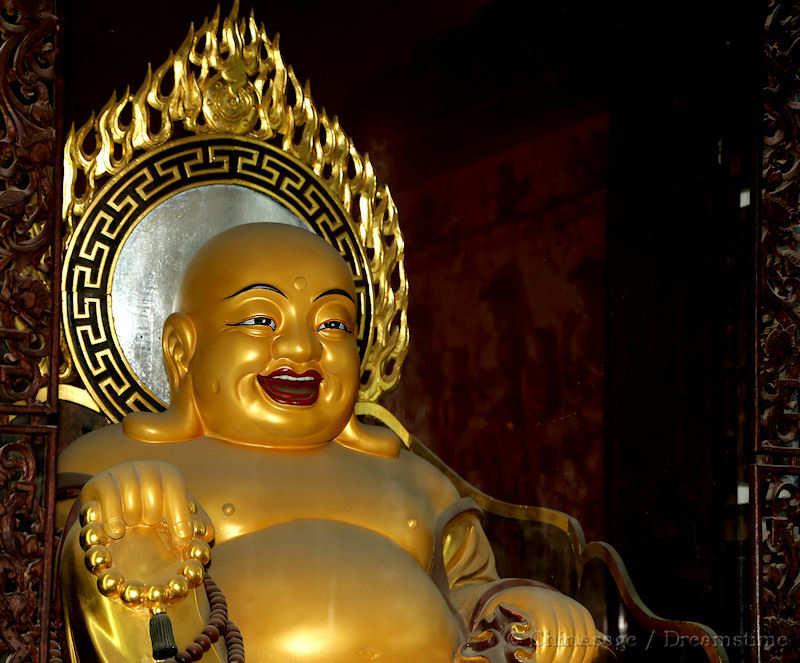
Mi Le Fo 弥勒佛
The fat, laughing figure is often seen on Chinese paintings and as sculptures. The ’Laughing Buddha’ represents the hope of future happiness. He is Maitreya, the Bodhisattva that will be the next to come after the Shakyamuni Buddha ➚. A legend says he came to live in Zhejiang province in the tenth century where he helped the poor and needy. He is full of boundless love for mankind. He is usually shown seated near the entrance to Buddhist temples and represents na?ve geniality.
Mulan 木兰
Mulan is the exception to the rule that warrior heroes of Chinese history are male. Mù lán is an ancient tale of a fearless young woman who took the place of her elder brother to serve in the army for several years. The Emperor wished to honor her great valor in battle, but she chose to return home rather than take riches or a title. Only when she returned home to her father did she reveal she was a woman. Two epic Disney ➚ films are based loosely on the story. Mulan is also the Chinese name for the admired magnolia tree.
Nezha 哪吒 No Cha WG
This legendary hero (also known as Nuozha) of the Shang dynasty is portrayed as a youth wielding a magic gold bracelet that he could increase in size at will. He also bears a spear and rides a fire chariot. He is mentioned in the famous book the ‘Journey to the West’. He was able to stave off the attack of the Dragon King. In one tradition the layout of the city Beijing is based on the form of his body.
Nuwa
The wife or sister of Fuxi, the first of the Three Sovereigns, considered the creator of mankind, see section on the Legendary Era.
Pan Gu 盘古
The creator of the Universe according to tradition in China is Pangu. He was the child of ‘yin’ and ‘yang’ and is shown as a dwarf in a bear skin. Other legends give different stories including one where Pan gu is the primal egg (盘 pán can mean shell of an egg) from which he and then all life hatched. He holds a hammer and chisel and fashions the cosmos out of solid rock. He is the great architect and is helped by qilins, tortoises, phoenixes and dragons. The creation took 18,000 years and after that his body ‘decayed’ to become the heavenly bodies, mountains, humans and other parts of the world. This legend seems to have appeared as late as 220CE and may have come from India. It is mainly known among the ethnic people of southern China.
Pengzu 彭祖
Pengzu is reputed to have reached 800 years old, at the age of seventy he was said to still have looked like a baby. The quest for immortality in China goes back a long way, and is particularly associated with Daoists. It was considered that by careful control of the qi 'life essence' an age of 120 could be achieved, by knowing the dao 'way' an even greater age could be reached. Pengzu is the emblem of this dream and is often depicted praying and burning incense surrounded by children. When portrayed on a gift he symbolizes a wish for long life.
Pu Sa 菩萨
The term Bodhisattva ➚ is transliterated in Chinese as 菩提萨陀 Pú tí sà tuó in Chinese which can be further abbreviated to just Pu sa. A Bodhisattva is an enlightened Buddhist that continues in the cycle of rebirth to work for the good of others.
Pu Xian 普贤
The Buddhist God of Universal Benevolence (Samantabhadra ➚ 普贤菩萨) is usually portrayed riding a white elephant. Puxian is particularly associated with the sacred Mount Emei Sichuan. He wears a yellow robe with a red collar and often carries a lotus. He is one of top Buddhas and often displayed in prestigious places in Buddhist temples.
Qing Long and Bai Hu 青龙; 白虎
The blue dragon qīng lóng and white tiger bái hǔ perform the same duties for Daoist temples as Heng and Ha do for Buddhist ones, they act as guardians. Bái hǔ Deng Jiugong of the Shang dynasty was a general and wounded by Heng becoming the spirit of the Blue Dragon star. Yin Chengxiu was an official who went as an emissary to Jiang Ziya but was executed by him. His son then went to avenge his death and was killed to be later canonized as the spirit of the white tiger.
San Qing 三清
The Three Pure Ones (Yu Qing 玉清: Jade Azure; Shang Qing 上清: High Azure and Tai Qing 太清: Supreme Azure) are a triad of Daoist gods that rule over the three traditional divisions of the sky. Yu Qing is the Jade Emperor while Shang Qing governs yin and yang and Tai Qing is the celestial form of Laozi himself.
Shangdi 上帝
Shangdi is the Supreme sovereign and ancestor, it is he that gives power to the Emperor. He punishes the bad and rewards the good. He is omniscient and omnipresent and acts through his ministers Guan Yu, Cheng Huang and Tu di. The belief in this ancestral god somewhat faded by the time of the Han dynasty and he is venerated mainly by followers of Confucius. The Emperor was thought of as his representative on Earth and only the Emperor could worship him as he was the only conduit to heaven.
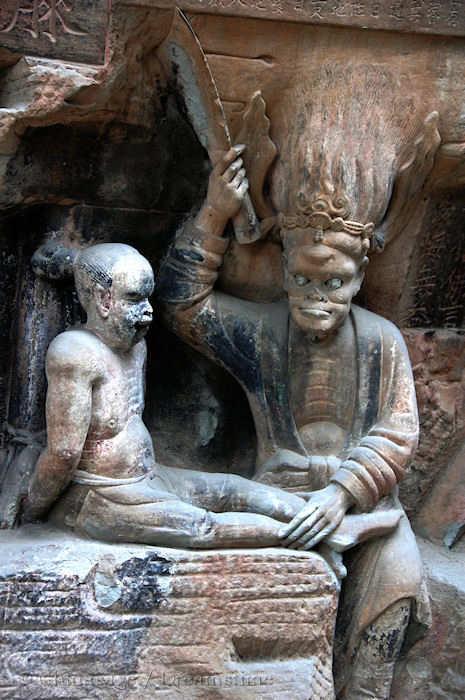
Sheji 社祭
The god of Earth and cultivation uses his power to good rulers to bring bounteous harvests.
Shengren 圣人
People who have lived exceptional lives are canonized and called shèng rén (similar to a western ‘saint’ and ‘sage’) and live in the Yu Jing (Jade Azure) part of the sky.
Shennong 神农
One of Three Sovereigns, god of agriculture and medicine, see section on the Legendary Era.
Shenshu 神荼 and Yulü 郁垒
According to the Shanhaijing ➚ the Jade Emperor ordered Shēnshū and Yùlù to guard the peach trees of immortality which were being attacked by demons. They are widely depicted as door guardians to ward off evil.
Emperor Shun
One of the Sage Emperors, see section on the Legendary Era.
Si Da Tianwang 四大天王
The four Celestial kings Sì dà tiān wáng are guardians of the Universe. They act as Temple guardians and are also associated with the four seasons and four elements (fire, air, earth and water). Li carries a pagoda, Ma a sword, Zhao two swords and Wen a pointed stick.
Sun Wukong 孙悟空
The Monkey King Sūn Wùkōng is the hero of the famous book ‘Journey to the West’ which tells how Xuanzang and his followers traveled to India to bring back Buddhist scriptures. He is endearingly dismissive of authority and loyal to his friends. He wields a cudgel stick that can grow to any size he chooses. He is mischievous but very clever and full of energy. A famous TV series was made about his antics in the 1980s and he remains one of the most popular Chinese deities. He is the god of official messengers.
Tianhou 天后
Tianhou is the Daoist Empress of Heaven, and is another name for the goddess Mazu 妈祖 and somewhat akin to the Buddhist Guanyin. In Hong Kong she is called ‘Tinhau’.
Tudi Gong 土地公
The guardian of the rural countryside and wild places is Tudi. The similar deity Sheji has jurisdiction only to cultivated areas of land.
Village deity
Each village had its own deity, worshiped at the village temple. There would be at least one big festival each year in its honor. As neighboring villages had different festival days a district would have some sort of village fair going on all year round. At the fair, many stalls would be set out selling all kinds of goods and produce. Gambling games would be held. Acrobats, local opera and shadow theaters would perform to the delight of the visitors. It was one of few opportunities to socialize outside the home (often family) village.
Wen Chang 文昌王
The God of Culture and Literature is based partly on the life of an exceptional Tang scholar Zhang Ya born in Zhejiang. He moved to Zitong, Sichuan where he was worshiped as a god after making a mysterious disappearance. He is often associated with a wise serpent. Other legends base Wen Chang on Zhong Kui who although exceptionally talented was so ugly that the Emperor refused to hire him. In despair Kui threw himself in the sea but was rescued by a sea monster. He is represented as standing on the head of a fish (carp) brandishing a writing brush. He went to heaven and lives among the stars. Wén Chāng wáng is associated with four acolytes : a servant, the Celestial Deaf man, the Earthly Dumb man and Kuixing (a fat dwarf with a demon's face). It is Kui xing who brings luck in examinations.
Wenshu 文殊
Wenshu, the Chinese name for Manjushri ➚, is the Bodhisattva of transcendental wisdom. The Wutai mountain, Shanxi is sacred to him.
Wu Chang 吴广
Leader with Chen Sheng of a rebellion against the Qin dynasty to set up the Chu kingdom before the Han dynasty began. He is often seen in effigy as a door guardian (with Chen Sheng) of Daoist temples.
Xi Shi 西施 Xī shī
She was foremost of the ‘Four legendary beauties’ 四大美女 Sì dà měi nǚ. She lived c. 700-600BCE and was given by Gou Jian of the Yue kingdom as a concubine to the king of Wu as part of a successful ploy to destroy the Wu kingdom. She so entranced Gou Jian that he neglected his kingly duties and he was easily defeated.
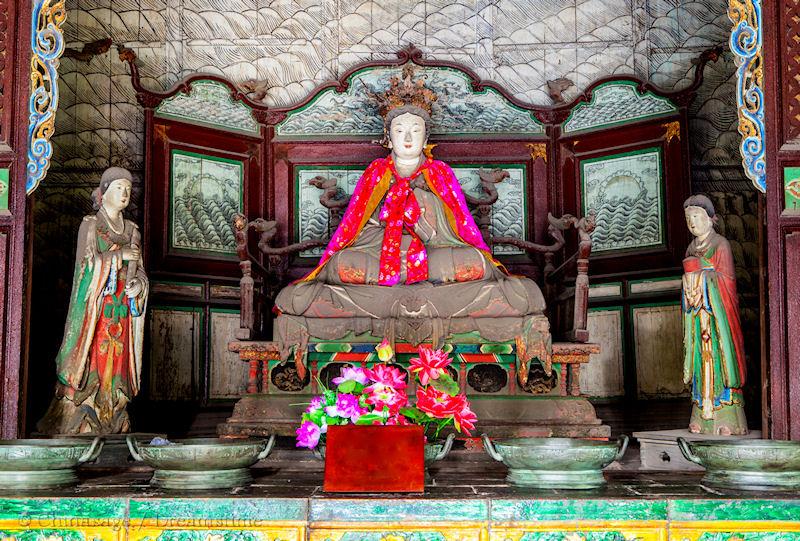
Xi Wangmu 西王母
The Queen Mother of the West ➚ (xī wáng mǔ) is the spirit of pure yin as the opposite of Dong Wanggong pure yang. She lives in the Kunlun mountains in far western China defended by a spirit army. She is sometimes portrayed with a panther's tail and tiger's teeth. She represents integrity and virtue. Her palace is bedecked in gold and precious stones and is the location where the gods hold their banquets. Great emperors of antiquity visited her on occasions. It is possible that she is based on an historical leader of a separate kingdom in western China a little like the Queen of Sheba ➚. She is mostly associated with the quest for immortality as the peaches of immortality grow there, and it was there that the Monkey King stole some. She was one of the most revered of Chinese deities and her worship was fanatical in the later Han dynasty. She is often attended by two young girls one with a fan and the other a bowl of the magic peaches. She flies on the back of a crane and is accompanies by bluebirds and phoenixes.
Xianren 仙人
While Buddhists seek paradise in the life after death, Daoists seek immortality. The Daoist adept will build up qi in the body until it fills the whole person, then the body metamorphoses and although seeming dead, life continues. A xianren ‘immortal person’ is someone who has reached this extreme level of perfection.
Yanluowang 阎罗王
Yan is the king of the fifth court of hell (地狱 dì yù in Chinese). He was demoted from the first circle for not being brutal enough. He is the Daoist equivalent to Yama ➚ the Buddhist God of Death. He judges and punishes the deceased.
Emperor Yao
One of the Sage Emperors, see section on the Legendary Era.
Yao Wang 药王
The King of Medicine showed incredible literacy at an early age. He was initiated into the mysteries of immortality and yin and yang. The Dragon King presented him with a set of secrets to benefit mankind. He was friend and doctor to Tang Emperor Gaozong. He is depicted with two young helpers one with a gourd of pills while the other holds the leaf of a medicinal herb.
Yellow Emperor
One of the Sage Emperors and one of Three Sovereigns, considered the founding father of China, see section on the Legendary Era.
Yu the Great
One of the Sage Emperors and founder of the Xia dynasty, see section on the Legendary Era.
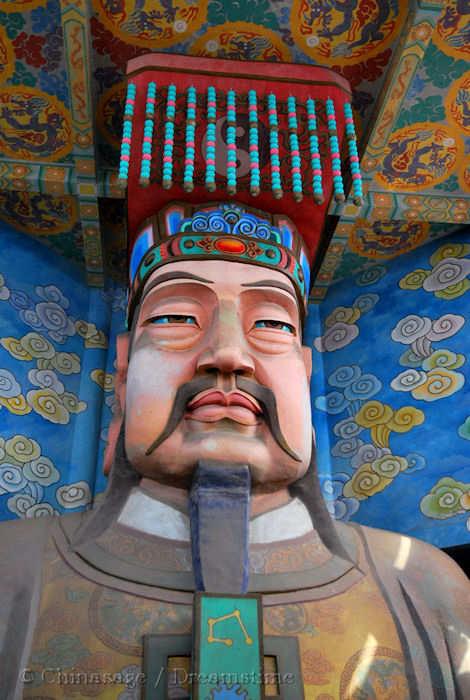
Yudi 玉帝
The Jade Emperor or Pure August One (Yu Huangdi) is the Daoist supreme sovereign of the Universe somewhat similar to Shangdi; there are many cross-overs with Buddhist deities too. He was able to command all sorts of spirits and genies as well as the kings of hell. In the famous story ‘Journey to the West’ the Jade Emperor rules heaven. He is one of the trinity of Three Pure Ones. He came into prominence under Song Emperor Zhenzong who claimed to have contact with the Jade Emperor. This supposed connection helped stabilize his rule in troubled times.
Zao Jun 灶君
The Hearth or Kitchen god (also known as Zaoshen and Zaowang) is an important god because Zao Jun observes the conduct of every family. With food being so important to a family he controls the health and prosperity of the home. It is on the eve of Chinese New Year that families pay particular deference so that he can relay a favorable report on the household's activities to heaven for the last year - his lips are smeared with honey. Traditionally a portrait of him was hung in the kitchen which was ritually burned and replaced every New Year. Originally, before the Song dynasty, he was important as the God of Furnaces and associated with alchemy.
Zhang Daoling 张道陵
Zhāng Dàolíng or Zhang Ling was a sage of Daoism, born 35CE during the Han dynasty he quickly learned all about Daoist concepts of yin-yang, astronomy and nature. He developed recipes for potions for immortality and alchemy. By the age of 60 he had perfected the immortality pill by uniting the blue dragon and white tiger. Eventually he moved to Yuntai in Sichuan from where he ascended to heaven in 157CE leaving a magic book and sword.
Zhang Guo Lao 张果老
One of the Eight Immortals - See above.
Zhang Qian 张骞
Zhāng Qiān was a historical figure from the Han dynasty [164-113BCE]. He served as a diplomat and explorer of Central Asia. Over the centuries his life has gathered legends, he is said to have discovered all the animals. He journeyed all the way to the source of the Yellow River where he met the goddess Qi Nu. He became a Daoist immortal often shown on a raft and carrying a gourd.
Zhongli Quan 钟离权
One of the Eight Immortals - See above.
Zhenren 真人
The ‘Perfect Beings’ are adepts at the highest level of Daoist practice who have perfect control over themselves and nature. They live in the Shang Qing High Azure heaven.
Zhinu 织女
The Spinning Damsel Zhinu was a daughter of the sun god who was concerned that she spent too much of her time spinning and wanted her to marry his neighbor the Herdsman 牛郎 Niulang across the Milky Way. She soon followed his wishes and was married but then entirely neglected her spinning tasks in a life of dissipation. Her father was so angry that he separated Niulang from her husband. They could only meet once a year on the seventh day of the seventh month. To make a bridge over the Milky Way he commanded magpies to spread their wings. As they would only come if it was dry she earnestly prayed for rain to keep away on that day. Nowadays this event is celebrated as Chinese Valentine's Day.
Zhong Kui 钟馗
Zhōng Kuí, the Demon Queller or Ghost Catcher, is one of the most powerful deities for keeping away evil spirits. His picture is displayed at the Dragon Boat Festival (summer solstice) and also by front doors to keep out evil. He may be shown wielding a sword attacking the five noxious creatures. He is shown with wild hair, fierce eyes and a sword. His hideous looks resulted in him being denied an official position at court despite coming top in the Imperial examinations. In some traditions he is also the god of examinations Kui xing .
Zhuge Liang 诸葛亮
Although not a deity as such, Zhuge Liang is a much admired historical figure from the Three Kingdoms Period. His clever strategies helped Liu Bei found the Kingdom of Shu. Zhuge twice pretended not to be at home when Liu Bei came looking for him so he could judge how determined Liu Bei was to recruit him. He was known as the ‘sleeping dragon’ as his skills had not yet come into play. He guided not only Liu Bei wisely but also Lui's son. His most famous action was persuading Sun Quan, the king of Wu to join Liu Bei against Cao Cao at the battle of Red Cliffs 208CE.
He was eulogized over the following centuries. The great Ming writer and loyalist L? Liuliang ➚ (1629-83) wrote:
Oh Zhuge Liang, little is left of your dreams of unity.Translation from Johnathan Spence's Treason by the Book p. 111
On every side the flowers are scattered, the trees have fallen.
The troops of Qin and Chu reach across the land,
East and West beyond the borders, desolation spreads.
From Qin and Jin the armies come, marching to Yan and Zhao.
As autumn fades even the crows can find no food.
Everyone across the land is about to perish;
All countrymen must arm themselves with swords and spears.
You ask who will live to see the good days come again?
Only those who hide out in the mountain caves.